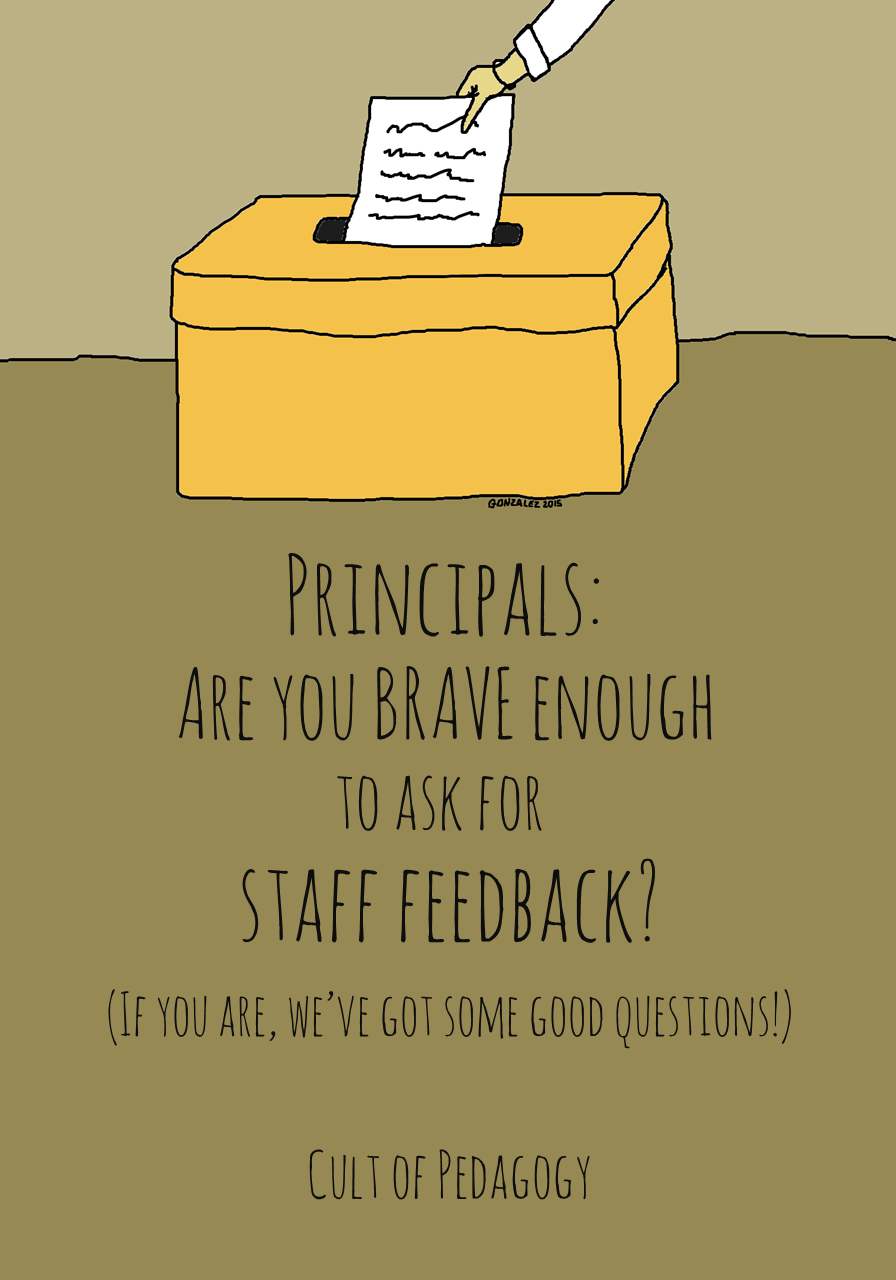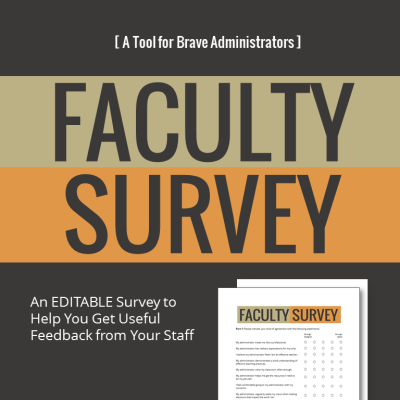Principals: Are you brave enough to ask for staff feedback?

“Criticism may not be agreeable, but it is necessary. It fulfils the same function as pain in the human body. It calls attention to an unhealthy state of things. If it is heeded in time, danger may be averted; if it is suppressed, a fatal distemper may develop.”
~ Winston Churchill
No one likes criticism. It’s in our nature as humans to avoid it, sometimes at all costs. Still, hearing what you need to work on is one of the only ways you get better. And if you’ve taken on the incredibly complex and demanding job of school administrator, you probably have plenty to work on. Your staff is one of the most valuable sources of information you have about your school culture, whether students are getting what they need, staff morale, and how effectively you’re doing your job.
The question is, are you taking advantage of this resource? Are you asking for feedback from your staff? If you are, if you’re asking quality questions and seeking honest answers, then you’ve probably grown quite a bit as a result, and your staff is probably grateful for the opportunity to express themselves.
If not, then maybe it’s time to start. Maybe this is the year you take a deep breath and ask.
Getting Quality Feedback…for Real
It’s possible that you think you’ve been asking for feedback, but you have been doing it in a way that isn’t producing results. Maybe you occasionally mention something general to your staff like, “Hey, if anyone ever has suggestions or feedback for me, just let me know.” Or in your start-of-the-year speech to the faculty, you mention that you have an open-door policy — teachers should feel free to talk to you any time they’re having a problem.
Only two types of employees will take you up on this offer: Those who have a close relationship with you, and those who are very, very bold. In our 2014 survey of teachers’ attitudes toward their administrators, a full 70 percent said they would not feel comfortable going to their principals with a concern about something the administrator had done. This doesn’t mean problems don’t exist; it just means very few people are willing to tell you about them.
To get genuine, honest feedback, ask for it in a way that protects the respondents’ anonymity, allowing them to speak their minds freely without fear of repercussion. You can do this by simply telling teachers to leave their names off their responses, or distribute the survey through a free online survey platform like Google Forms, SurveyMonkey, or Typeform.
This doesn’t mean you should open yourself up for harsh, snarky, non-constructive criticism: Before launching any kind of survey, tell your staff that you are seeking feedback so you can improve, and request that they stick to comments that are professional and constructive.
You also need to ask good questions.
Suggested Items for a Faculty or Staff Survey
To get a full, clear picture of how well you’re doing, ask questions that prompt teachers to consider your performance from different, specific angles, while allowing them to also provide more open-ended feedback. The following are some suggested survey items.
This first set is a list of positive descriptors. Have respondents indicate the extent to which they agree or disagree with statements like these:
- My administrator treats me like a professional.
- My administrator has realistic expectations for my time.
- I believe my administrator feels I am an effective teacher.
- My administrator demonstrates a solid understanding of effective teaching practices.
- My administrator visits my classroom often enough.
- My administrator helps me get the resources I need to do my job well.
- I feel comfortable going to my administrator with my concerns.
- My administrator regularly seeks my input when making decisions that impact the work I do.
- My administrator supports my decisions about student behavior.
- My administrator supports me when conflicts arise with parents.
- My administrator cultivates a positive relationship among faculty members at this school.
- I feel empowered to make decisions about my teaching.
- I enjoy coming to work most days.
- I feel we have a positive school culture.
- In general, I believe our school is meeting the needs of our students.
It’s also a good idea to include some open-ended questions to help root out problems that can’t be detected by the statements above. Here are a few good open-ended items:
- I feel my administrator is strong in these areas:
- I would like to see my administrator grow in these ways:
- I believe our school is working well in these areas:
- I would like to see our school change in these ways:
Finally, leave room for other comments or suggestions that don’t necessarily fit into any one category.
What to Do with Your Results
Once the feedback comes in, you’ll need to brace yourself for reading things you don’t like. For some people, even getting an “agree” when they could have gotten a “strongly agree” is enough to hurt.
Push through it. You can handle this. Whether a person’s feedback is fair or not, grounded in reality or not, it’s true for them and therefore has some impact on your school.
With an anonymous survey, you obviously won’t know who said what. This makes follow-up tricky. Avoid trying to hunt down people who made specific comments: This will destroy the trust you built in the first place by establishing anonymity. Instead, look for patterns. If more than one person marked you down for something, it’s worth taking a good look at your practices in this area. Share your results with someone who knows you well and whom you trust — this could be a spouse or partner, another administrator, or even a teacher whose opinion you respect — and ask them to give you some honest feedback based on your results.
If you choose to share your results with your staff, do so carefully — be sure to remove anything that might put a spotlight on anyone, such as a comment that’s obviously from one particular teacher. Keep the focus on you and how you can better serve your staff.
Then, make a plan. Set some goals for improvement in the areas where you need the most growth, and after some time has passed, ask for input again.
Getting feedback is rarely pain-free. Neither is growth. But the rewards you’ll reap from going through the process — happier teachers who stick around, a school that truly meets the needs of students, and the priceless knowledge that you’re doing a good job — are worth it. ♦
I have a great one in my Teachers Pay Teachers store. It’s a fully editable Microsoft Word file that’s ready to print and use as is (containing the questions in this post), or you can add questions of your own. Click here to take a look.
Join my mailing list and get weekly tips, tools, and inspiration — in quick, bite-sized packages — all geared toward making your teaching more effective and joyful. To thank you, I’ll send you a free copy of my new e-booklet, 20 Ways to Cut Your Grading Time in Half. I look forward to getting to know you better!
